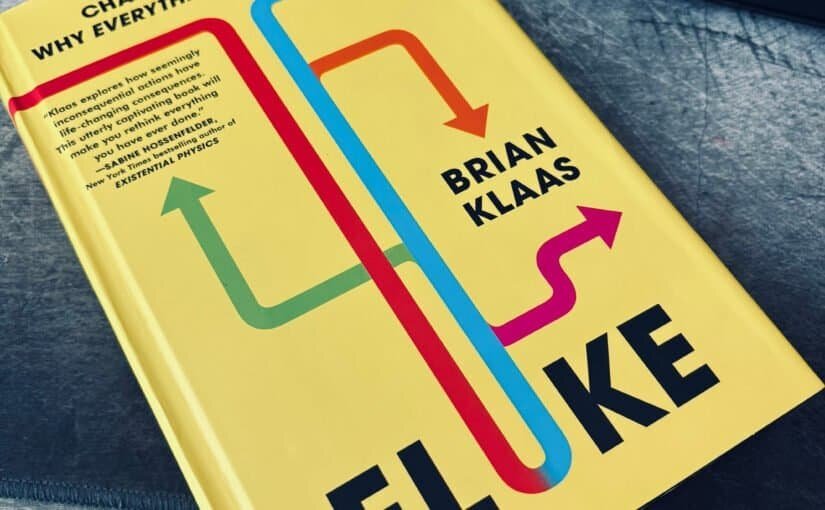Contents
Introduction to “Fluke”
Fluke provides a compelling exploration of how randomness, chance events, and misapplied cause-and-effect reasoning shape everything from human evolution to the complexities of modern society. The central message emphasizes the importance of recognizing both the hidden forces of complexity that govern our world and our inherent tendency to impose order where none truly exists. Through insightful concepts such as self-organized criticality and chaos theory, the book illustrates how small and seemingly insignificant changes can lead to radically different outcomes. This phenomenon echoes the unpredictable nature of financial markets, where sudden “flash crashes” and “black swan” events can occur without warning.

Moreover, Fluke highlights the ongoing tension between convergence, where repeated patterns emerge, and contingency, which represents random occurrences. This tension is crucial in understanding why even the most rigorous models, despite their sophistication, often struggle to predict large-scale, emergent phenomena in economic and social systems. Ultimately, the book urges readers to embrace complexity and uncertainty as fundamental aspects of life, encouraging a more nuanced perspective on the forces that shape our world.
If you’d like to purchase the book on Amazon, please follow the links below:
1) Paperback
2) Hardback
Below are my thoughts on Fluke and how its concepts could be applied to financial markets and quantitative trading.
Calculated Risk vs. Irreducible Uncertainty
In quantitative finance, risk is often modeled via known distributions (e.g., normal or lognormal). Fluke reminds us that true uncertainty—where the rules themselves shift or remain unknown—renders many standard statistical techniques unreliable. Hence, we should be careful about the distinction between risk and uncertainty, and not so overconfident about our calculated risk. Markets are adaptive, so consistent stationary processes rarely hold for long.
Narrative Bias & Overfitting
Fluke highlights that human minds have a natural tendency to seek stories that explain performance and market movements. This inclination can lead to overfitting data or creating misleading “just-so” stories in hindsight. To counteract the temptation of simplifying narratives, it is important to adopt rigorous falsification methods, as well as cross-validation and robust testing. These approaches can help ensure that our interpretations are grounded in reality rather than appealing but inaccurate narratives.
Complex Adaptive Systems
Fluke emphasizes that financial markets are not only highly adaptive but also interconnected. This interconnectivity can create feedback loops, where small changes or signals in one part of the market can lead to exaggerated effects, resulting in significant price fluctuations across different assets. In such a volatile environment, it is essential to focus on building resilience in investment strategies. This can include practices like diversification—spreading investments across various asset classes to reduce risk—and dynamic hedging, which involves adjusting strategies based on changing market conditions. These approaches tend to be more effective than relying on overly rigid or hyper-optimized strategies, which may not be flexible enough to adapt to sudden market changes.
Thinking beyond Fluke
Promise of Agent-Based Modeling (ABM)
When numerous market participants continually adapt, agent-based simulation models can reveal tipping points that top-down or purely statistical models miss.
Promise of Fat-Tailed Distributions & Fractals
Real price data often show volatility clustering and heavy tails—Mandelbrot’s fractal analysis can offer a better fit than neat Gaussian assumptions. If you’re interested in this idea, you can check out the YouTube video below: The (Mis)Behavior of Markets: A Fractal View of Risk, Ruin and Return
Promise of Adaptive Market Hypothesis
The Adaptive Markets Hypothesis, as proposed by Andrew Lo, parallels Fluke’s idea that success in one context may not guarantee success in another. Markets evolve like ecosystems, rendering static trading models vulnerable.
Actionable Insights for Quant Trading
Account for Non-Stationarity
Continuously recalibrate and monitor your strategies—markets can change faster than any single model can adapt.
Scenario Analysis & Stress Testing
Evaluate how extreme outlier conditions (black swans) might impact your trades. Standard risk measures (e.g., VaR, CVaR) often miss game-changing tail events.
Exploration before Exploitation
Test strategies on small scales for exploration to probe diverse market conditions, before committing large capital.
Embrace Interdisciplinary Approach
Borrow from fields like biology, chaos theory, and network science to understand and predict the emergent behaviors that purely financial models can overlook.
Conclusion
Ultimately, “Fluke” serves as a reminder to remain humble in the face of uncertainty. In quantitative trading, the true advantage lies in acknowledging the limits of our control, systematically preparing for the unpredictable, and continuously adapting strategies to remain resilient in an ever-changing environment.
If you’d like to purchase the book on Amazon, please follow the links below:
1) Paperback
2) Hardback
Related Reviews
- Review of Thinking in Bets by Annie Duke
- Review of Fluke by Brian Klass
- Review of Untangling Skill & Luck by Michael Mauboussin
Author:
